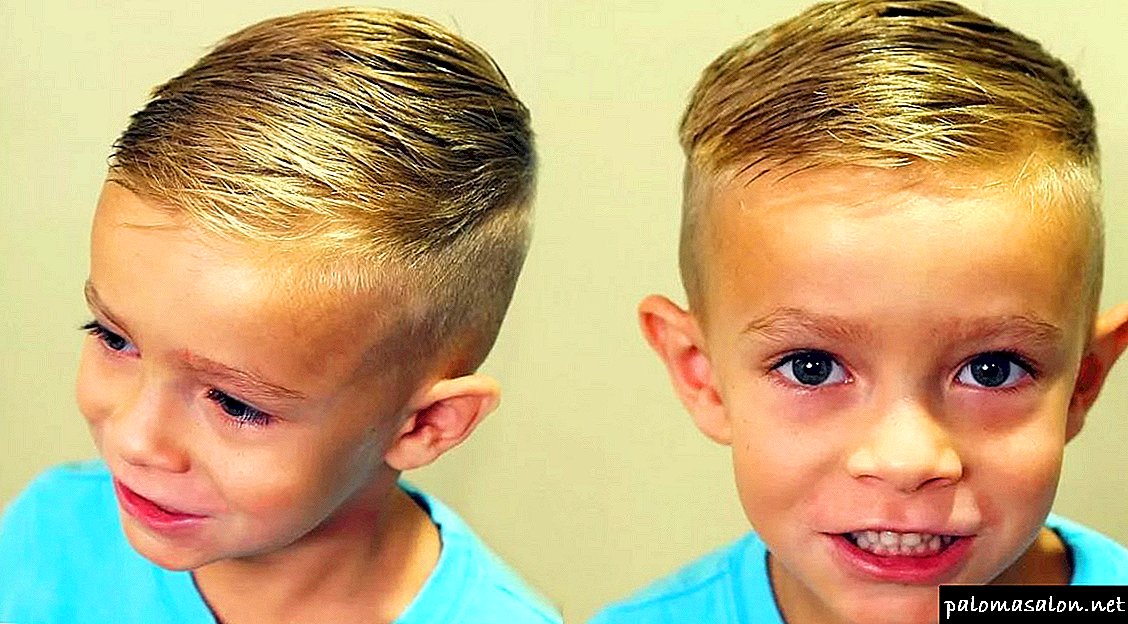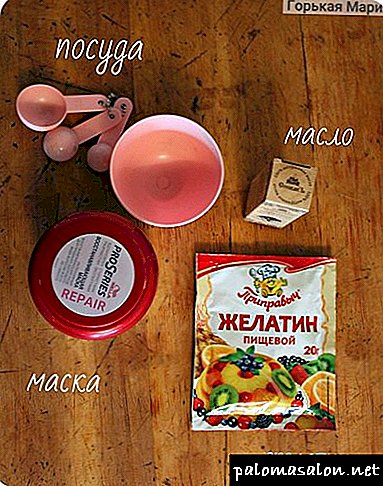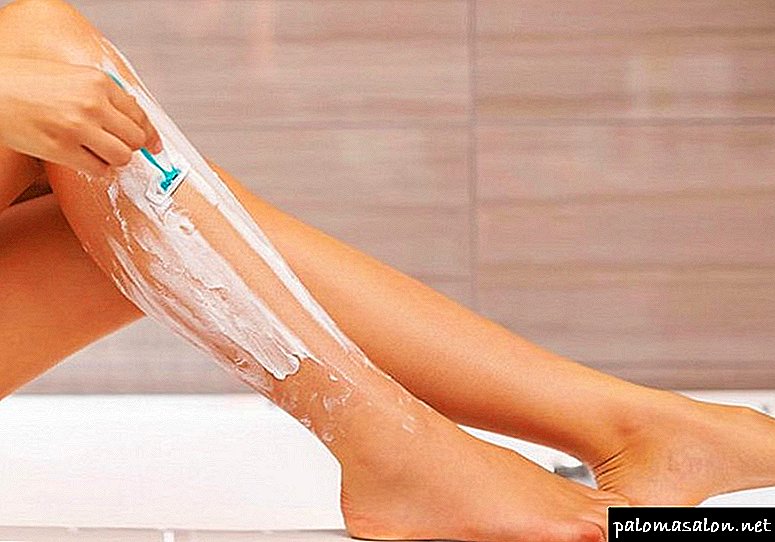
I don't need to tell you how unpleasant your ingrown hairs are, if you have ever had this problem, then you know how much it hurts, how itchy and annoying. This problem occurs when "the hair curls and grows back into the skin, It can lead to red, itchy spots and white acne.
So how can we get rid of them? Here is all you need to know from the Medicorum website.
What do ingrown hairs look like
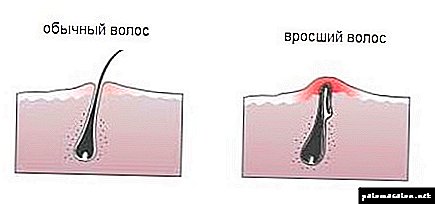
Ingrown hairs are not a dangerous skin disease, but can cause discomfort and discomfort to a person. Ingrown hair is a small brown or reddish color on the skin in the form of a tubercle with serous or purulent content, in which growing hair can be viewed (or not viewed).
Hair ingrowth occurs because after shaving, hair removal or hair removal hair does not grow outward, but deep into the skin, causing inflammation and irritation. This is because dead skin clogs the hair follicle, causing hair to grow under the skin, not up and out.
Symptoms of ingrown hair
In men, ingrown hairs most often appear after shaving in the beard area, around the neck, cheeks and chin. They can also appear on the surface of the head if the man shaves it. Ingrown hair in women is most often on the legs, in the area of the bikini line and pubis, in the armpits and around the buttocks. The signs that indicate unwanted hair include the following:
• Solid bumps, small and round (so-called papules),
• Small pustules that are filled with pus or serous contents,
• Itching, hyperpigmentation of the skin, pain.

Causes of ingrown hair
Ingrown hair most often occurs after the procedure of hair removal in your own bathroom, but it happens that after visiting beauty salons such an unpleasant phenomenon happens. In order to understand how to get rid of this problem, you need to carefully figure out what provokes it. Cosmetologists say that the process associated with ingrowth directly depends on the number and density of the epidermal layers. If the surface contains a significant amount of cells in the stratum corneum, they make the skin too coarse, so it is difficult for thin growing hair to make its way out. For this reason, a hair begins to follow a path of less resistance, starting to bend and grow horizontally rather than vertically, as is usually the case.
If we consider the type of skin and hair, then people with dark, hard hair and dark skin are most susceptible to such a problem. The reason is that this type of hair grows much faster than blond hair. We add to everything else dense skin, and avoid ingrowth will not succeed.
Therefore, the reasons for such an unpleasant phenomenon include the following:
• a thick layer of the epidermis (hyperkeratosis),
• impaired hormones (for example, estrogen surges observed at the beginning of the menstrual cycle). Changes of this kind can occur with high estrogen production, as well as with endocrine disruption,
• causing damage to the hair channel during the hair removal procedure,
• formation of a small scar in the hair channel after epilation,
• hair flaking is lower than epidermis level. This occurs if errors were made during the hair removal procedure,
• shaving against hair growth (especially when the blade is not new),
• Constant wearing of uncomfortable underwear made of synthetic material.Such underwear does not allow moisture to evaporate from the surface of the skin and often leads to the development of bacterial infections. Because of this, after hair removal, it is not recommended to immediately put on synthetic underwear.
It is imperative to get rid of ingrown hairs, but before carrying out such a procedure you should understand what you should not do.
Causes of the inflammatory process
Allocate the main provoking factors:
- Depilation at home. Usually use a razor, strips of wax, electric epilator. These methods eliminate the upper part of the hair, and the follicles remain intact. As a result, the depilation should be done more often. Each procedure changes the structure of the hair. It becomes thinner and weaker. Horny cells make the skin coarser. The hair is difficult to break through the coarsened epithelium, and it changes the direction of growth.
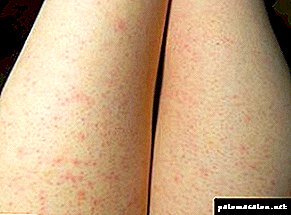 Ingrown hairs
Ingrown hairs
More details about provoking factors that provoke such a condition can be obtained from a dermatologist. What looks like ingrown hair, shown in the photo.
Epilation as a provoking factor
Many are interested in the question: do hair grow when they plan to do hair removal? The answer is yes. Especially if the technology was not respected. During the procedure, some hairs bend and break. Begin to grow deep into the skin. If there is a lump, this may indicate the appearance of pus and the inflammatory process.
It is better to do hair removal in the cabin. If salon treatments are not affordable, proper skin care is necessary. To do this, use special tools, and moisturize the skin before the procedure.
Peeling the day before the hair removal removes the dead cells from the skin. After epilation, apply a moisturizer.
Therapies
To fix the problem, you must first understand why ingrown specimens appear. The reason may be in the way of epilation or the structure of the skin. How to deal with ingrown hairs will be prompted by a specialist. You can consult a dermatologist or a cosmetologist. He will tell you what to do to keep your hair from growing. Treatment of the problem is as follows:
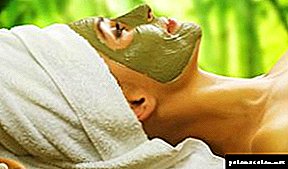
A special scrub will help in eliminating ingrown hair.
- photo epilation or photo depilation,
- special gels, napkins and scrubs,
- peeling at home
- medical removal,
- waxing,
- mechanical removal method
- antibiotics.
Injury of the hair follicle
It happens quite often as a result of improper hair removal techniques. And if for an outdoor bikini, where hair all grows in one direction, it is easy to observe the technique and remove everything by growth or against hair growth, but here for the depilation of a deep bikini the professionalism of a depilation wizard is very important.
Several procedures for improper hair removal can provide the client with permanent problems with hair growing in the future.
Constant friction of clothes
If usually friction on the edges of the linen and the seams of clothes do not cause discomfort, then the skin injured during depilation can react to the touch of the fabric with irritation and redness. Irritation is a predisposing factor for the appearance of ingrown hair, pustules at the site of damaged follicles.
The cause of irritation can be not only narrow clothing, but also linen from synthetic fabrics that do not absorb moisture and create the so-called "greenhouse effect".
Hormonal changes
Is it true that after shugaring hair grow less?
In fact, there are no ways that cause hair ingrowth to a greater extent than other methods of depilation. Shugaring came to us later than hair removal with wax and epilator.
Because some time it was advertised as a method that does not cause hair ingrowth. Time has shown that this is just a marketing ploy.
Most importantly, the hair should be removed with minimal damage to the hair follicles.
How to remove them in the bikini area
Treatment of ingrown hair should begin with simple methods and gradually move to traumatic (surgical). You can arrange them from simple to complex in the following order:
- compliance with the rules of skin care after the procedure of depilation,
- steaming and softening of the skin,
- the use of scrubs and moisturizer,
- the use of exfoliating agents (enzymes, salicylic acid, bodyaga),
- removal of ingrown hairs with tweezers or needles,
- autopsy of boils at the site of ingrown hairs at the surgeon.
Let's look at each of the methods in more detail.
Find out if quantum epilation has contraindications. If so, which ones?
What methods are best for making male hair removal in the bikini zone, read here.
Rules for skin care after depilation
Usually each of the masters tells in detail how and what to do after the procedure. But rarely one of the clients really follows these rules. Therefore, the results are not always encouraging. Here are the rules:
- Immediately after the procedure, you should use underwear only from natural fabrics, rather loose about the cut,
- at least a day after the procedure, it is necessary to abandon the relationship of nylon tights,
- for several days it is better not to wear very tight pants and jeans,
- on the first day you should not swim in open ponds, visit the pool and sauna, take a bath,
- after showering, it is necessary to treat the skin in the bikini area with an antiseptic solution, for example, chlorhexidine, and apply a thin layer of Bepanten ointment,
- until redness disappears, it is recommended to limit sex;
- While the redness after the procedure persists, it is not recommended to apply cosmetic products to the skin.
Steaming and softening of the skin
Often, such a procedure is enough to make it easier for the growing hairs to go out. For steaming, you will need a piece of soft cloth and warm water. Or you can use the folk method, when bread and warm milk are used for steaming the skin.
You can repeat the procedure several times until the skin is so thin that the pores are opened and the upper layer of the epidermis is not loose enough so that you can easily remove ingrown hair.
The use of funds with the effect of peeling
Photo: a mixture of bodyagi powder
The simplest option is the use of lotions for the treatment of acne. Typically, these lotions include azelaic or salicylic acid, which have a marked peeling effect.
You can also use ready-made products with enzymes such as papain and bromelain, which not only exfoliate dead skin, but also slow down the process of new hair growth.
Alternatively, you can use a mixture of powder and hydrogen peroxide. The gruel must be applied to the area of hair ingrowth for 10 minutes every day for a week.
Needle removal
Doctors themselves strongly discourage them to remove them with a needle or tweezers at home, as there is a risk of spreading a purulent infection. But you will not go to the surgeon with every ingrown hair, because in most cases women will cope with the problem on their own.
The most important thing is to use antiseptics and remove only those hairs that are located on the surface and have no signs of purulent inflammation around them.
When to seek help from a surgeon
A surgeon should be advised about ingrown hairs when subcutaneous "bumps" are formed, which become larger or smaller. This usually means that a wavelike process of suppuration occurs in the hair follicle, which then becomes stronger, then disappears.
Do not expect that the "bumps" will pass by themselves. If there is no outflow of pus, the hair remains in the tissues, the inflammation will recur.
There are cases when such subcutaneous abscesses are opened independently. Then, except for pus, one or several hairs can come out of them. But it also happens that the inflammation spreads to the surrounding tissues and an abscess is formed, which requires emergency surgical treatment.
An attempt to independently develop an "abscess" with a needle or squeeze it out by pressing fingers or nails can provoke the development of an abscess.
Video: How to remove hair in the intimate area
What to do to prevent this from happening
If you have tried everything that is described in the article, changed the wizard and the method of hair removal, but your results have not improved, then you will have to forget about depilation or continue to suffer from ingrown hair. An alternative to depilation is laser, photo, electro or ELOS epilation.
These methods allow you to get rid of ingrown hairs in two or three sessions.
Prices for hair removal, of course, are not comparable with the cost of depilation procedures, especially if you spend them at home. But the comfort of getting rid of in the bikini area is worth it.
Read what tools are used for pain relief during laser hair removal.
I wonder how to make the bikini area hair removal hot wax? Watch the video link.
Read reviews on diode laser hair removal at this address.
What not to do when removing ingrown hair
Most try to deal with the problem with the help of scrap items, but such actions often lead to complications. Therefore, below is a list of those actions that should be avoided:
• Use tweezers or a needle that is too sharp without prior treatment, because such manipulations can lead to infection and further inflammation,
• Once again, do not use the method of hair removal, after which such a problem manifested itself,
• Do not crush the hair follicles in the place where the hair grows, because it can lead to the outpouring of serous or purulent contents deep into the skin.
Ways to remove ingrown hair after epilation
What to do if hairs begin to grow after depilation? They are necessarily carefully removed, so as not to cause additional inflammation. You can get rid of the ingrown hair using the following methods:
• If they are not too deep and there is no inflammation, just rump the skin and do a home chemical peel or scrub. You can also use a hard washcloth or a special mitten to remove the dead cells of the stratum corneum. Removal of dead cells of the stratum corneum can be done every other day, and the skin after such procedures should be treated with a moisturizer or lotion.
• If there is inflammation, but there is no purulent bubble or hair stuck deep, mechanical hair removal is performed. This method is described in detail below. Mechanically ingrown hair can be removed at home, but it is better to provide this procedure to a specialist so that complications do not arise.
• Surgical removal of ingrown hairs is performed when a pustule is formed with serous or purulent contents and there is extensive inflammation. Such a procedure can be carried out by a surgeon in an ordinary clinic. Surgical method of ingrown hair removal consists in opening an abscess, debridement and removal of hair. The wound is treated with an antiseptic and a bandage or bactericidal adhesive plaster is applied.
• Photoepilation is carried out only in the cosmetology office.Ingrown hair is destroyed by the action of a light pulse. For very light and gray hair is not suitable.
• Electrolysis is also performed only by a beautician. Ingrown hair is removed even at great depth with the help of a needle-electrode through which electric current is passed.
• Laser hair removal. The most used and effective technique today, is applied on any skin color.
Hardware procedures are carried out only in the absence of inflammation and suppuration.
• Also, to solve these problems, you can use traditional methods of ingrown hair removal, they will help to pull the rod to the skin surface. To help the hair to break through the skin, it is necessary to prepare a compress of several aspirin tablets, one spoon of glycerin, and water. This lotion handles the problem place. As a result, the hair itself will begin to sprout out, and it will have to be removed with tweezers, then do not forget to disinfect the skin with an antiseptic. Another type of lotion: make a slurry of bodyagi powder and hydrogen peroxide and apply on ingrown hair for 10-15 minutes, then rinse. If the burning is strong, wash off earlier.
Mechanical removal of ingrown hair at home
Step by step instructions will help us to remove ingrown hair at home. For this manipulation, you need to stock up with a thin sterile needle (if the hair is deep) and manicure tweezers. Before starting the procedure, medical tweezers are necessarily treated with medical alcohol or an antiseptic (chlorhexedine).
1 step. We steam out the skin in the shower so that the pores are maximally dilated Using a scrub, get rid of the dead layer of the skin.
2 step. The area of ingrown hair is also treated with alcohol or an antiseptic.
3 step. It is necessary to find the tip of the hair and gently pick it up with a needle, slowly pulling it out, pinching out the hair, pinching it with tweezers and tearing it out with the root. At this stage it is extremely important not to break off a hair and extract it completely, otherwise it will grow again.
4 step. Lubricate the skin with antiseptic or better alcohol tincture of calendula, which has anti-inflammatory effect.
This method is suitable only in the situation when the ingrown hairs are clearly visible.
Ingrown hair in bikini area
Sometimes a thin ingrown hair in the groin cannot be seen through the skin. In this situation, we soften the epidermis so that the hair is closer to the surface. To do this, impose on the skin steaming compress or take a bath. Please note that such manipulations can be performed in the absence of inflammation. As soon as hair becomes noticeable, we perform mechanical removal of ingrown hair. All instruments that you will use must be sterile. If after steaming the hair did not become visible, do not try to get rid of it. In this situation it is best to seek qualified help from a cosmetologist. At the same time, a specialist will help to understand what exactly caused the seal.
Ingrown hair in armpits
This is probably the most annoying option. First, in these places there is extremely thin skin and it is constantly irritated. Secondly, self-removal of unwanted hair will bring a lot of discomfort. Finally, due to the use of deodorants and the sweating of the area where this hair is located, pain is often felt and inflammation appears due to the addition of an infection. Therefore, the operation must be carried out extremely carefully:
• A few days before removal, we begin preparation - we treat the skin with acne preparation, which contains salicylic acid in its composition. Such lotions are too aggressive for the face, but in the place of the hair they lead to thinning of the skin and stop the inflammatory process,
• Just before removal, remove the remaining salicylic ointment, steam the skin, process all the tools,
• If all previous steps are done correctly, then even with the naked eye it will be possible to examine the ingrown hair. We carry out the procedure of hair removal and wipe the place with an antiseptic.
Drugs used to treat ingrown hair
After visiting the beautician, he may prescribe some drugs that will help get rid of the annoying problem. This list includes:
• Retinoids. The doctor in some situations prescribes creams that help remove dead skin cells from the surface (the so-called peeling). These include the drug tretinoin. They help alleviate hyperkeratosis, which means thickening, and hyperpigmentation - darkening of the area, which can often be seen on dark skin, which is prone to hair ingrowth,
• Corticosteroids. A good steroid blend helps control the process associated with inflammation,
• Antibiotics. Ointments, which are based on antibiotics, can prevent infection, which is attached due to damage to the painful area. If the infection continues to be severe, then oral antibiotics may be prescribed for treatment.
Possible complications with ingrown hair
The chronic version of the problem can lead to the following unpleasant consequences:
• Injection from damage of a bacterial infection,
• Darkening of the skin - the so-called pigmentation,
• Scars, including
• Folliculitis - inflammation of the hair follicle.
Preventing hair ingrowth
It is best not to bring the ingrowth of hair, and resort to the prevention of this phenomenon. Before you start to deal with the problem that appears after epilation, you need to change the approach to the procedure for getting rid of hair. Agree, it is extremely stupid to do the same actions all the time, and hope for a positive outcome.
Preventive measures to prevent hair ingrowth:
• Shortly before epilation, perform an exfoliating procedure (light peeling or scrubbing) to get rid of dead skin cells,
• Shaving should be carried out strictly in the direction of growth, but not in the other direction,
• After removal, it is important to scrub or peel lightly, which is then repeated several times over a couple of days,
• After any depilation, be it shaving, waxing or shugaring, you should apply a special hair growth inhibitor to your skin or at least a moisturizer.
• After epilation is finished, do not wear uncomfortable synthetic underwear, as this can lead to relapse.
Ingrown hair: photo
Ingrown hairs on men face
Latest forum topics on our site
- Teacher / Interested in methods of facial rejuvenation.
- Christmas tree / What lipstick can you recommend for dry skin of your lips?
- Dasha87 / Separate meals
- Lucia / Who makes anti-aging masks at home?
- Tit / Which mask is better to do for dry hair?
Reviews of the procedure Ingrown hair after epilation: causes, symptoms and removal methods
Leave your feedback on this procedure (it will appear on this page after moderation) In this form, describe only
private experience from going through the procedure.
To leave a comment regarding the content of the article, use another form - in the “comments” box at the bottom of the page.
Other articles
Getting rid of unwanted vegetation on the body through the use of various techniques is an everyday ritual for every woman. After certain manipulations, the hairs may become more rigid, moreover, more serious associated problems often occur. Ingrown hair in the bikini area bothers every second woman who regularly depilates.
Why do such troubles arise?
The main reason that contributes to the rapid hair ingrowth in the intimate area is the pathological change in the trajectory of their growth. Hair is not able to break through on its own, it begins to grow in a horizontal direction. Such phenomena may occur as a result of their own negligence, lack of experience, non-professional actions of a cosmetologist.
Initially, a hair that began to grow into is similar to a painful red furuncle. If you do not take measures to prevent or eliminate the problem, the inflammation may increase, spreading to a larger surface of the skin. In the advanced stage, ingrown hairs in the bikini area can lead to the formation of wounds, which often becomes the cause of more serious diseases.
How are ingrown hairs diagnosed?
Carrying out diagnostics is possible even for an amateur and is based on an analysis of the appearance of the skin. Initially, the surface is itchy, there are redness, small point formations. When the problem becomes more serious, medical intervention is required with a biopsy of small areas of the skin. A specialist, by manipulating a cotton applicator, can take samples of a bacterial culture in order to reliably determine the cause of the infection.
Some diseases of the skin may have signs identical to ingrowth, therefore such manifestations cannot be treated with disdain. Accuracy and attentiveness to your body will help to keep your skin healthy. Ingrown hair in the bikini area, causing serious concern, is a reason for immediate medical attention.
How to get rid of the problem? Useful recommendations
The hair, continuing its growth inside the skin, can cause extremely unpleasant sensations, irritation, itching, and formation of pustules. The skin in the intimate area is very thin and sensitive, it reacts sharply to any manipulation. To minimize the risk of ingrown hairs, it is advisable to adhere to the following recommendations:
- Many times reduce the likelihood of developing a similar problem will help exfoliating procedures. Deep impact will not only free those hairs that have already begun to grow, but also will not allow the appearance of new foci.
- If in the intimate area often grows hair, after epilation you can not visit the solarium, the beach. The effect of ultraviolet radiation can exacerbate the problem.
- Skin after any manipulation must be deeply moisturized. Only then you can count on a flat, smooth, healthy areas after depilation. Such procedures relieve the epidermis from the formation of excess particles, which act as a kind of barrier to normal hair growth.
- Even when the hairs have already grown, they can be carefully removed. To do this, the skin is thoroughly steamed and ingrown elements are removed with tweezers. Do not use needles and other sharp objects - the problem can only get worse. If the hair remains inaccessible, you should stop any actions and contact a professional beautician.
Cooking “medicine” by yourself
Almost all the mixtures that are designed to get rid of ingrown hair, you can cook yourself. The most popular are the following recipes:
- The crushed aspirin tablets are mixed with glycerin in equal shares. Freshly prepared substance is applied to the problem area for two hours. This tool is quite effective in the case when hair grows. After epilation, the mixture softens the skin, and unnecessary elements are removed with tweezers.
- Badyagi powder, diluted with hydrogen peroxide, is applied to the bikini area for 15 minutes, then washed off with moderately warm water. After the procedure, it is recommended to treat the skin with a fat baby cream. The mixture is applied to the problem area for five days. As a result, microcracks, ingrown hairs are eliminated, wounds heal.
- If it came to purulent inflammation, it is recommended to use medications. Salicylic ointment showed good results.
Scrubs - Prevention and Care
It should be noted separately such means as a scrub for ingrown hairs. It has both preventive and therapeutic effects. To solve the problem, you can use any of the presented recipes.
Ingredients: 50 grams of Hercules cereal, honey, rich sour cream.
- Hercules grits are ground into flour.
- The powder is mixed with the other components.
- The result should be a moderately thick mass, which is applied with a thin layer to the problem area and gently rubbed.
- After treatment, the mixture is washed with warm water.
Coffee scrub against ingrown hair
Ingredients: ground coffee - 2 tbsp. l., olive oil.
- Coffee, ground almost into dust, is diluted with olive oil to the consistency of thick cream.
- The mixture is applied to the bikini area, gently rubbed and washed off with warm water.
Ingredients: half a glass of sugar.
The sequence of actions: after a shower or bath, while the skin is steamed, the areas of the most frequent hair ingrowth are treated with granulated sugar. After the procedure, the remnants of the sweet mass are washed off with water. Sugar-based scrubbing is particularly effective, regardless of why hair grows (after an epilator, a razor or as a result of unprofessional actions of a pseudo-cosmetologist).
Salt is a good antiseptic. A scrub based on it can be an excellent preventive measure to block hair ingrowth. So…
Ingredients: 3 tbsp. l finely ground salt.
The sequence of actions: salt, slightly moistened with plain water, is gently rubbed into problem areas after depilation and washed off with warm water.
The main objective of any scrabbing is to remove dead skin particles from the skin, after treatment a deep exfoliation is achieved. The procedure helps the hairs grow in the right direction. Scrubbing should be moderate but regular. If the skin in the bikini zone peels off - this is a clear contraindication to the conduct of such manipulations. If you do not follow the simple recommendations, the question of how to get rid of ingrown hairs, will be much sharper.
The main causes of ingrowth
The problem may occur regardless of the method of depilation. A razor, an electric epilator, and some cosmetology salon procedures can equally provoke hair ingrowth, especially in sensitive areas.
The reasons for the formation of ingrown hairs when using a razor may be as follows:
- old tool that does not have the proper sharpness
- shaving the hair in the wrong direction
- lack of hygiene procedures,
- lack of post-epilation care.
A razor makes the edges of the hair sharp, which can have an additional irritating effect and cause itching in the groin area.
Hair removal with electric epilator at home
In this case, the main causes of the unpleasant phenomenon are as follows:
- using the wrong nozzle,
- exposure to the epilator without prior preparation of the skin,
- illiterate manipulation of the device.
To minimize the risk, it is recommended to pre-steam the skin in a hot bath. And even better - eliminate home depilation.
Depilation in the salon
Many young ladies who do not want to risk, trust the master to take care of their own body. On the one hand, this is correct, but on the other ... Oddly enough, but sometimes going to the salon turns into extra costs and a headache. And the reasons are commonplace:
- low level of qualification of the master,
- lack of preparation,
- the use of cosmetics that are not suitable for the client's skin type.
To avoid such troubles, you should visit only proven centers and not save on yourself, beloved. It is much more efficient and more beneficial for health to visit a highly professional beautician who, by means of modern techniques, will save you from extra “vegetation” for a long period. And then the recommendations on how to get rid of ingrown hairs will become irrelevant.
Pharmaceuticals allowed for use in epilation
- The drug “Miramistin”. Strong antiseptic. The tool helps to eliminate the ingress of bacteria and microorganisms in the pores of the skin after removal of hair onions.
- “Chlorhexidine” is an antiseptic drug. Blocks the development of inflammation after epilation.
- Furacilin. A drug with a pronounced antimicrobial action. Eliminates any accumulations of pathogenic flora on the skin after hair removal.
- Antibacterial agents from ingrown hairs in the form of solutions. It is necessary to choose for processing only those drugs that are intended for external use.
- Ointment for ingrown hair. Means “Retin-A” reduces the manifestation of pore blockages or hyperkeratosis. The epidermis becomes thinner, the resistance of dead cells decreases, and the hair growth in the follicles is delayed. It is recommended to use corticosteroid ointments in the development of local inflammation of medium strength. If the inflammatory process has gone too far and caused the occurrence of co-infections, it is better to use antibiotics for local use.
How to prepare the skin for hair removal
To prepare the skin for the procedure, do the following:
- The day before epilation, it is desirable to clean the skin from the dead cells with a soft scrub and moisten it with any fat cream. The cream will relax the skin and soften the hair follicles, which will make epilation less painful.
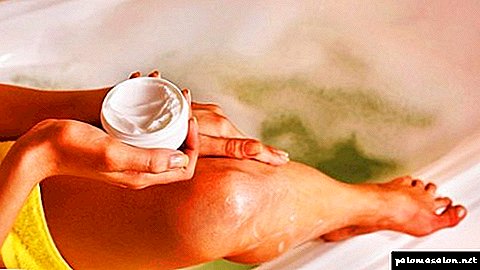 Moisturize your skin with a cream before the procedure.
Moisturize your skin with a cream before the procedure.
You can use a special cream that reduces pain sensitivity, or take an anesthetic pill.
Preventive measures
To achieve the desired result, you can use special lotions that slow down the hair growth phase. Active substances have a direct effect on the cells of the follicles. In addition to lotions, sprays are on sale, they also work against growing hairs, have moisturizing properties and help soften the stratum corneum. After using such funds hair can grow normally.
Skin care after epilation
After epilation, skin should not be scrubbed., lubricate with creams or lotions. It must be carefully wiped with hydrogen peroxide or chamomile extract. Lotion can only be used cosmetic soothing action.
Skin scrubbing and normal care can be done 2 days after epilation.
As for epilation of the intimate zone, there are special rules for skin care, so that later ingrown hair in the bikini zone does not create a problem how to remove it:
- directly after epilation, it is necessary to use loose underwear made from natural fabrics, not to wear tight pants,
- on the first day to give up nylon pantyhose,
- refrain from sexual intercourse until skin irritation has passed.
In the first days it is useful after a shower to treat the intimate area with an antiseptic. Sunbathing and visiting the sauna for the first 3 days is undesirable.
Consequences of hair ingrowth
Often ingrown hair dies off and disappears by itself, or it manages to break through to the outside. If this does not occur, various complications can occur: inflammation of a nearby skin area, swelling, festering due to scratches, scarring. In such cases, consult a dermatologist and remove ingrown hair.
Regular care
A good preventive measure is scrubbing and carrying out appropriate procedures for the care of delicate skin in the bikini area. For detailed recommendations, you can contact your beautician, who will help identify the cause of the problem and prescribe the most appropriate means for a particular skin type.
In the event that the ingrowth continues and is gaining intensity, it is recommended to immediately stop epilation or shaving. Do not neglect the appeal to a dermatologist. The doctor will exclude the possibility of the development of more serious diseases. A simple ingrown hair, the photo of which is presented at the beginning of the article, may have similarities with the signs of depriving, fulliculose, phrynoderma.
How often can I resort to epilation in the bikini area
Any expert will say that the removal of unwanted hair in this area should be carried out no more than once every two weeks. Otherwise, you can achieve that the hairs become more coarse, and the ingrowth will increase.
As for the care of the intimate area, electric epilator in this case is not the best tool. This is due to the fact that in the groin the hair is initially stiffer than on other parts of the body. After the hair is pulled out with the help of the device, a wound is inevitably formed. Microtrauma always becomes the cause of the ingrown hair being formed in its place during the healing process. What to do? One of the best procedures is shugaring, which gently affects the skin during the depilation process.
The easiest way to prevent ingrowth of hair in the bikini area is not to shave or epilate the hair. In the modern understanding of the canons of beauty and grooming, no girl can afford it. To combat unwanted "vegetation" was effective and did not cause unnecessary consequences, it is recommended to use modern cosmetology techniques. That is, resort to the services of specialists. Only then the ingrown hairs in the bikini area will no longer cause anxiety. Be healthy and beautiful!
Regular depilation sometimes creates such an unpleasant side effect as hair ingrowth. When the ingrown hair turns into a bump, it is urgent to get rid of it, especially if the bump was formed in the bikini area. The defective place not only spoils the appearance of the intimate area, but also causes discomfort and creates prerequisites for infection of the body.
Mechanical removal method
From the defect of ingrown hair on their own get rid with tweezers. It is convenient to remove deep ingrown hair with a needle.
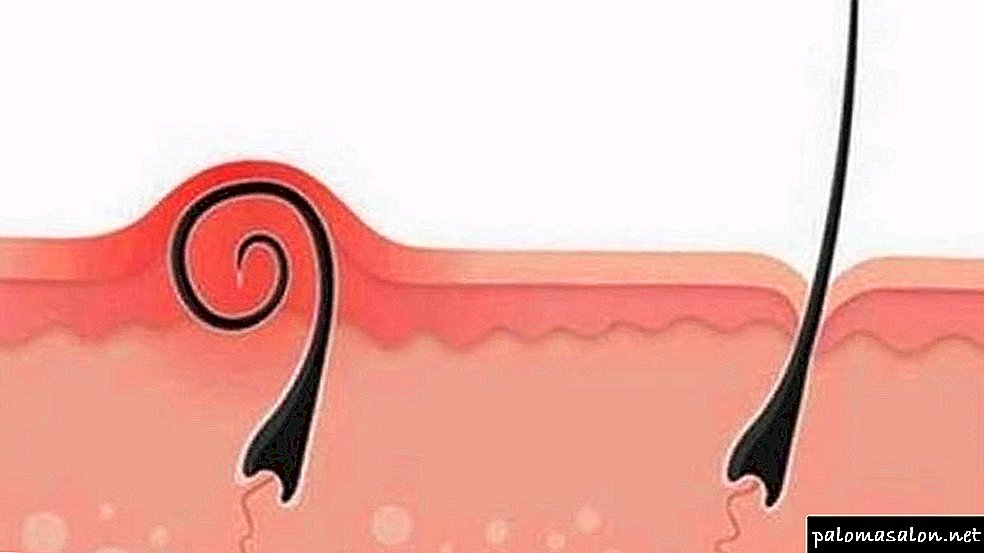 From the defect of ingrown hair on their own get rid with tweezers.
From the defect of ingrown hair on their own get rid with tweezers.
Before you pull out a hair that has grown, the instrument is rubbed with medical alcohol to prevent infection.
How to get ingrown hair:
- The skin should first be steamed with a hot shower or a warm compress. This will expand the pores.
- Scrub removes the cornified layer of the epidermis.
- Wash the area with ingrown hairs with alcohol.
- Pry off hair, pull out and remove.
- Treat the area with a special cream that allows you to slow down the growth of hair, so that no ingrowth occurs.
Alternative methods
After the epilator, hairs often grow into the skin. With the constant nature of the problem, it is necessary to change the method of removal. There are alternative methods of hair removal:
- Photoepilation Light affects the follicle, resulting in root destruction. It is necessary to carry out 5 procedures.Not recommended for use in dark tanning, pregnancy, cancer, breastfeeding, inflammation.
- Bioepilation (wax). Removal occurs with the bulb. Eliminates unwanted hair for 21-30 days.
- Electrolysis. Follicles are destroyed. Can be used for any type of epithelium, hair color. The disadvantage is the high cost and long course of procedures.
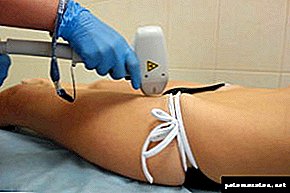 An example of laser hair removal
An example of laser hair removal
Causes of ingrown hairs and bumps in the bikini area
Why did ingrown hair in a bikini zone become a bump? There is one answer to this question - incorrect hair removal. If the vegetation during the procedure is not removed from the root, and breaks off, this leads to the fact that its lower part remains in the depths of the epidermis.
When trying to further grow the hairs, a lump forms - a manifestation of pseudo-folliculitis. Under the skin, a hair bends or twists and causes an inflammatory process.
The appearance of bumps on the site of ingrown hair due to several reasons:
- Damage to the bulbs during hair removal.
- Shave with a blunt machine against the "wool".
- The hair channels are clogged due to improper hair removal.
- Damage to the hair during depilation at the upper level of the epidermis.
- Increased skin density in the bikini area, which makes hair removal more difficult.
- Hereditary predisposition to hair ingrowth.
Also, hair can grow into the skin of the intimate zone and turn into bumps due to endocrine or hormonal disruptions in the body, which are completely unrelated to the epilation process, or with constant wearing of linen made of synthetic fabric. Artificial material does not absorb sweat and discharge and passes a little air, which increases the risk of inflammation and pseudo-folliculitis.
Control measures
Cones above ingrown hair in women can appear not only in the intimate area, but also in the lower limbs. Men sometimes have a problem after shaving their faces and neck.
If the ingrown hair penetrates the surface of the dermis, you can try to remove it with a thin needle:
- Sewing tools and skin are disinfected.
- The hair is tipped with a point and pulled out.
- The operated area is treated with alcohol or hydrogen peroxide.
- For rapid tissue regeneration using wound healing ointment.
But what to do if the hair has grown too deep into the bikini area, and a real red bump has already formed? First of all it is necessary to understand that the redness indicates inflammation with possible accumulation of pus. The situation at this stage, you can try to fix with the help of ointments, lotions, soft scrubs.
If the bump is enlarged in size and it hurts, it is better to contact a dermatologist. The doctor will open the papule with a sterile needle or scalpel, clean and wash the wound and close it with a sterile dressing. Disinfect the treated area with chlorhexidine or hydrogen peroxide. Bandages are changed daily.
Independent removal of cones
Home removal of cones in the bikini zone will seem difficult to someone, but to someone a very simple operation. If a girl does not want to go to the hospital, she can get rid of her ingrown hair and heal the affected skin.
How to carry out the proper removal of cones:
- For two days, lubricate the modified area of skin with external means Prodmer, Baziron, Dalatsin. Ointments will remove puffiness and redness.
- Use a scrub to remove dead skin particles of the dermal layer.
- Rinse the skin and give it a rest from various aggressive actions for several days.
Scrub for the treatment of bumps over ingrown hair is prepared from ground coffee, sugar and vegetable oil.The composition is alternated with scrub made from turmeric, olive oil and salt, or with store products.
To soften the bumps in the bikini area, on the legs and in the armpits, saline acid and benzoyl peroxide are applied to protruding points 2-3 times a day. Ointments and creams with such a composition relieve inflammation and accelerate regeneration processes.
Warm compresses are applied to the problem area in order to facilitate the exit to the surface of the stuck hair. Make a compress as follows:
- The towel is soaked in hot water and placed on the bikini area.
- The procedure is repeated several times, wetting in a boiling water a cooled towel.
Ready-made products for ingrown hairs and special impregnated wipes are sold at a pharmacy or cosmetic store. But they are expensive, and help is not always 100% effective.
How to prevent the formation of cones
Pseudofolliculitis, despite the prefix "pseudo", is an undesirable condition for the body. With such a problem, the skin looks inflamed and festering. Some people do not pay attention to the symptoms of pseudofolliculitis and do not treat it in any way. And in vain, because in most cases, the bulge can not only withdraw, but also to prevent their formation.
How to prevent the formation of cones when hair grows:
- Regularly engage in peeling and do not forget about it before hair removal. The result of the procedure is the elimination of dead cells.
- Use shaving machines with clean, sharp blades. People who often face the problem of growing hair, for the prevention of cones should not shave more than 2 times in 7 days.
- Wipe the skin thoroughly with antiseptic before and after epilation. Disinfection protects follicles from microbial infection and inflammation.
- Wear soft cotton underwear that does not hurt the delicate bikini area.
- To do wax and sugar hair removal only in the salon of an experienced master. Refuse to re-perform the procedure in a short time if ingrown hairs appear.
To cones never formed in the bikini zone, hair removal should be as rare as possible. As they grow, they become stronger and more susceptible to depilation.
What not to do if a bump is formed
Having noticed the bumps after the epilation of the bikini zone, many women try to remove them by hand with improvised means. Having read reviews about how to get rid of ingrown hair and bumps in the intimate area at home, a person is able to both help himself and exacerbate the problem.
It is impossible to pick a bump and pick up ingrown hair by yourself without a medical consultation. Any abnormal action of the philistine is fraught with the spread of the inflammatory process in the deep layers of the epidermal structure, and then the surgeon will cut the tubercle.
Mistakes that women and men often make when developing post-epilation inflammation:
- Treatment of the skin surrounding ingrown hair, depilation cream.
- Squeezing papules with your hands in an attempt to extract purulent contents.
- Neglecting the problem and using the hair removal method, which constantly leads to their ingrowth.
- Hair removal under the cones with non-sterile accessories.
- Reluctance to spend time on processing depilated surface with antiseptics.
All this leads to a gradual increase in the number of bumps and increased development of the inflammatory process. At the first signs of pseudo-folliculitis in the bikini area, doctors recommend contacting the clinic immediately. Otherwise, a reddened bulge will cause pustular skin lesions and sepsis - blood infection.
1. Frequently use scrub.
Ingrown hairs may occurwhen the hair follicle is clogged with dead skin cells.This blockage can cause hair to grow sideways, but regular exfoliation (once a week) will help prevent the accumulation of dead skin cells on the surface. Use Ameliorate Skin Polish Skin Softener to cleanse the skin. This combination of lactic acid and physical microdermabrasion granules makes it seriously effective in dissolving “dead cells that clog follicles.”
2. Consider hair removal creams
Shaving is the biggest culprit for ingrown hairs, because when the hair grows, it has a sharper edge and can easily be stuck back into the skin. The easiest way prevent ingrow - allow your hair to grow freely without shaving. But if this is not an option, it is worth trying a sensitive hair removal cream such as BodyCurv Veet's.
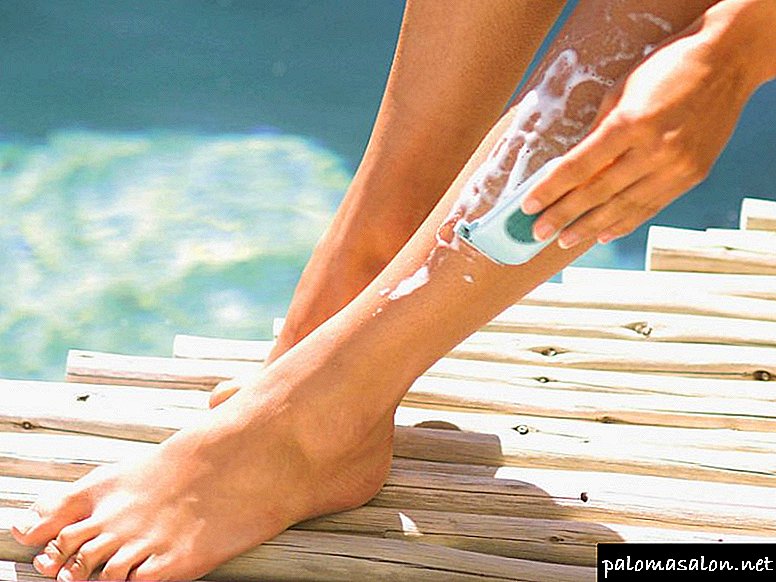
It can also solve the problem of ingrown hair, if it appeared due to shaving.
3. If you are going to shave, use the best razor.
remember, that disposable razors - it is really disposable. We were all in such a situation that the Bic yellow razor hid in the corner for a long time. At some point, you get a rash after shaving. This is because disposable razors are not designed for long-term use, the blades can get blunt quickly and leave hair uneven. Such shaving will only irritate ingrown hairs. Special women's razors are highly recommended by most reviewers on review sites, just remember to invest in a couple of extra shaving heads so that you will not be tempted to reuse the same one over and over again.
Another option is to invest in an electric razor. Philips Satin can be a substitute for a handheld razor. And, since it does not cut the hair quite as close as possible to the skin, this greatly ensures that you do not get any ingrown hair.
So maybe this is your option. Try such a razor and maybe it will solve the problem.
4. Remember shaving cream
If you use manual razor It is very important to find a good shaving cream.
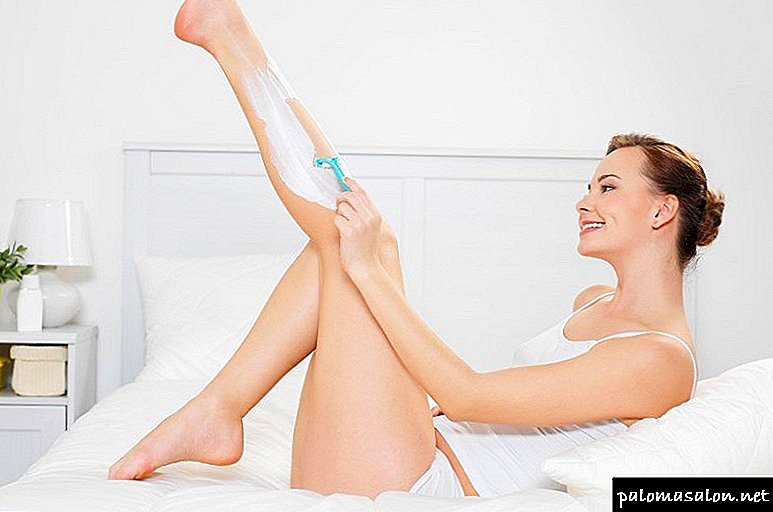
This will give additional protection to the skin, so that the blades will not shake, and this means that you can avoid irritating any sensitive areas. Choose an alcohol-free, sensitive formula to prevent skin from drying out.
6. Aftershave treatment
There are a number of aftershave products, some are good, some are not very good. Bliss' Inrown Eliminating Pads actually do what they promise on their packaging. The pads are impregnated with salicylic and glycolic acid - both of which are known for their ability to dissolve any formation of dead skin cells from the surface of the dermis and prevent clogged pores and ingrown hair. The formula also contains lavender oil and oat extract to soothe any irritations after shaving.
7. What to do if you find yourself with ingrown hair
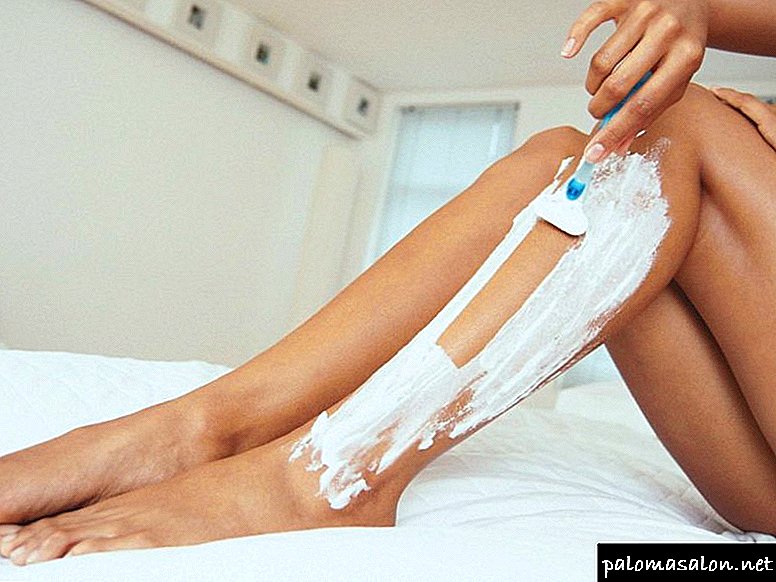
Cream for hair removal in the shower might be a good option. This is a cream that you put on your legs, leave for 3-6 minutes while you take a shower, then use a sponge to remove the cream (and hair). Hair removal cream may be a good option to consider, unlike razors, it does not cut hair at an acute angle, so you are less likely to get irritated, itchy when hair grows. This is not very practical. You should put on dry feet, wait one minute before getting into the shower (so it’s not an option if your bathroom is cold), and then remove after 3-6 minutes.
The battery-operated electric shaver has been designed for the bikini area, it has three shaving options that cut the hair to 0.5 mm, 3 mm and 5 mm. It is very easy to use, and the mini nozzle is good for hard-to-reach places. The shortest can be as low as 0.5 mm, which means that you will not get hell ingrown hair or razor bumps.
You can choose a small razor, which has a blade at one end, and on the other - a battery-powered hair trimmer.
This is practical. Having a wet razor and an electric trimmer combined is great if you are traveling and don't want to take all the hair removal products with you.The trimmer is great for styling a bikini line, but it's pretty tiny, so it takes a little time if you want to tackle large areas.
Earlier, experts told how to get rid of ingrown hair.
How to remove ingrown hairs in the bikini area
If the hair is thin, do not shine through the skin, then you must first soften the epidermis. This can be done by taking a bath, or by applying a hot compress to the skin. As a result, the hair will be closer to the surface. If after the measures taken, it is not visible, it is better to seek help from a beautician, and not to act independently.
It is most difficult to remove ingrown hairs in the armpits. Here is very thin skin, it is prone to irritation. Due to sweating and the use of deodorants, irritation often occurs on it.
People whose skin is dense, difficult to get ingrown hair. Care must be taken to facilitate access to it. Additional measures are needed. The inflamed area is smeared with salicylic acid or another acne preparation that contains it in its composition for several days. This leads to the fact that the upper layer of the epidermis is removed, the hair becomes visible.
Salicylic acid penetrates deep into the skin and causes blood flow to the site of inflammation. The inflammatory process stops, tissues are updated. The tool dries pimples, removes stagnant spots.
Before the procedure of removing ingrown hairs take a bath, all tools are thoroughly disinfected. The hair will be visible to the naked eye, it must be picked up with a needle and pulled out. The place where he grew up, wipe with an antiseptic. If the bumps are already formed, then it can be folliculitis. Its light forms pass by themselves, it is enough to treat the skin with calendula tincture, but when a purulent abscess appears, you should consult a cosmetologist.
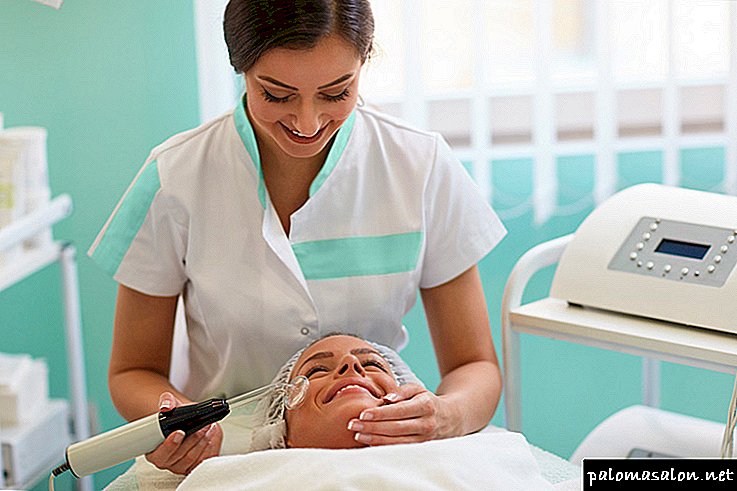 The specialist will remove ingrown hair, prescribe treatment.
The specialist will remove ingrown hair, prescribe treatment.
If the bump has increased and it is breaking, there is a fever, the help of a doctor is needed.
You can get rid of ingrown hair with scrubs, ointments and other means. But the easiest way to eliminate the negative factors that led to their appearance.
How to remove ingrown hairs on the legs
Among the main prophylactic agents can be called peeling. He polishes, removing dead cells, eliminates pollution and sweat. The skin after its application is soft and clean, it perfectly absorbs the beneficial substances contained in the cream or lotion.
At home, you can make peeling of the following types:
It is considered the safest mechanical, it is done 2-3 times a month. To remove ingrown hairs it is helpful to use a mixture of salt, sugar and soda. It is useful to add olive or essential oil to the mixture. But such a peeling can not rub the face, because when applied to sensitive skin, it can cause allergies.
The body is pre-steamed in the bathroom. The composition is applied to the feet with a tough washcloth, you can use special gloves. After completion of the procedure, sugar and salt are washed off with warm water, and then moisturize the skin with a cream.
Chemical peels are based on the use of acids. At home, you can use salicylic, very effective citric acid. Dairy cream is more suitable for sensitive skin, it not only gently peels off the upper layer of the epidermis, but also moisturizes it. All acids increase blood circulation and regulate the activity of the sebaceous glands.
Deciding to make a chemical peel, you need to consider safety. You can not exceed the concentration of acid, keep it on the skin longer than it is said in the instructions.
There are other tools that will facilitate access to ingrown hairs. You can make a mixture of moisturizer, sea salt and orange oil. It is applied in soft movements, and then washed off with cool water. After this place, where the hair has grown, smear it with another mixture. It is prepared by combining calendula tincture and salicylic alcohol in equal proportions.
It will take several sessions to get rid of the inflammation, the skin becomes smooth. Ingrown hairs that remain in some places can be easily removed with a sterile needle and forceps.
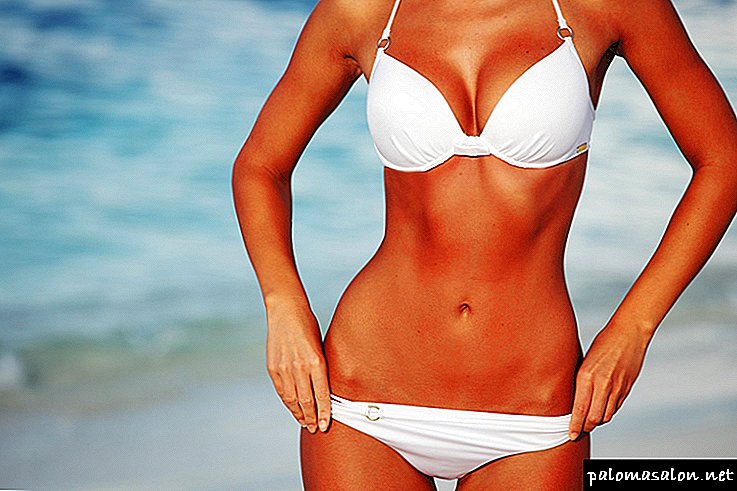 If hair removal is done correctly, the ingrown hairs will not appear.
If hair removal is done correctly, the ingrown hairs will not appear.
A mixture of glycerol and aspirin is effective. It is applied on the inflamed place, hold for 1-2 hours. After that, the hairs will be easy to pull out with tweezers.
Aspirin is very effective in prophylactic purposes. In order to prevent hair from growing into the skin, it is rubbed with a solution. It is made by stirring 2 tablets of medicine in 0.5 cups of water.
Useful badyaga, powder is mixed with a solution of hydrogen peroxide. The composition is applied to the body, wait 15 minutes, and then wash off with warm water. After that rubbed into the skin cream. It is necessary to do 5-7 procedures in a row, applying the mixture daily. After the course of treatment, stagnation will disappear.
Prevent ingrown hairs is easier than treating. The guarantor of the absence of inflammation will be compliance with the rules of hair removal, as well as timely prevention of the disease.
Ingrowth after removal
Non-physiological removal leads to ingrowth, which can cause a change in the location of the follicle. Shugaring is carried out physiologically (implies work with sugar paste). But waxing, depilating hair, performed against their growth, provokes the development of skin under the skin. A deformed rod cannot break through the epidermis to the outside. It turns out that shugaring is a safer procedure than waxing. But after sugar epilation, ingrowth can also occur if you have poor skin care (forget about peeling, cream).
Growing hair after depilation looks unaesthetic and can be a dangerous process. The skin turns red, there are bumps on it, often itching, pigmentation, inflammation, ulcers. Cream for hair removal can cause allergic dermatitis, shaving dangerously cuts that allow infection to enter the body. Both methods often lead to ingrowth, folliculitis. Women should use a means of ingrowing hair, which is able to slow down their growth, use washcloths to get rid of dead cells.
Warning: the use of wax at home is fraught with both ingrowth and burns. Inflamed areas need treatment, the skin must be disinfected. When shaving, it is better to use a single-blade machine to avoid skin injuries and inflammation.
Hair removal: the most effective way
The safest, most effective device for getting rid of vegetation is the neodymium laser. It acts exclusively on melanin in the rod, without affecting the skin. The beam quickly destroys the bulbs. For maximum results, laser hair removal is performed in a course of 7-12 procedures. Photoepilation, laser removal exclude ingrowth, the appearance of folliculitis. The ideal device for removing hair without pain - setting FQA20-5. The device will warn all the problems that cause depilation, shaving.
An important plus of laser procedures, in addition to a virtually painless session, is that there is no need to grow the bristles, which cannot be avoided by applying sugar paste or wax, a depilator. The installation will not cause harm to very dry skin, which is too sensitive to traumatic manipulations and responds to the procedures by ingrowths, purulent processes. After epilation, up to 90% of hair goes away, the rest grows weak, almost imperceptible. Between treatments, it is reasonable to shave off vegetation; wax can damage follicles.
Tweezers remove the scorched elements, you can not pull the living.
Self-treatment of pseudofolliculitis
It is important to know! The doctor may advise treatment. But the disease is chronic. Treatment can only be symptomatic and does not relieve the problem.
It consists of the following activities:
- local steroid use to relieve inflammation or swelling,
- use of antibiotic ointment to treat infections
- removal of dead skin cells using retinoids.
A radical way to treat pseudofolliculitis is to remove ingrown hair from the skin. It is necessary to know how to remove ingrown hair on the neck, legs, in the bikini area correctly, so as not to get complications.
Professional medical care
If pus has formed in the place of ingrown hair, it is better to consult a doctor. It is also advisable to do this because the symptoms of pseudofolliculitis are similar to the symptoms of diseases such as folliculitis, acne and a number of other skin ailments.
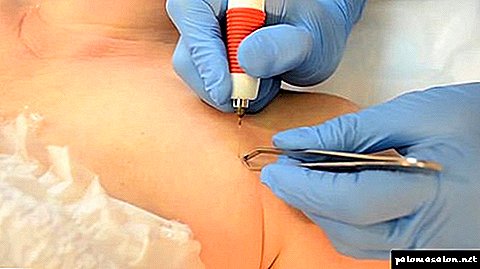 If you have ingrown hair, it is better to consult a doctor.
If you have ingrown hair, it is better to consult a doctor.
The doctor will perform simple manipulations, clean the wound from pus, but it will do it professionally and efficiently, under sterile conditions.
Prevention of pseudofolliculitis
In order not to think later about how to remove ingrown hair in the bikini zone without pain and complications, it is better to refuse shaving and depilatory creams at all, but to use more progressive types of epilation.
But if nevertheless preference is given to the razor, then you need to know how to shave the intimate area so that later there is no reason to remove ingrown hair in the bilini zone.
It is necessary to shave hair only in the direction of their growth. and do not shave the skin too smoothly, and after the procedure, cool the treated surface to relieve irritation (you can use a towel moistened with water).
 Try to use more modern methods of hair removal, in order to avoid their growth.
Try to use more modern methods of hair removal, in order to avoid their growth.
To prevent the ingrowth of the hair shaft, it is necessary to remove it in the growth direction along with the bulb, while the paste is applied in the opposite direction.
Even in a small area, hair can have several growth directions. An experienced master before starting work will identify these zones and will work with each separately.
Safety and comfort are worth visiting professionals for epilation.
In the following video, you will learn how to get rid of ingrown hair:
In this video you will learn how to avoid ingrown hairs:
This video tells about the fight with ingrown hair:
What you should not do when removing ingrown hair
Most try to deal with the problem with the help of available items, but such actions often lead to complications. Therefore, below is a list of those actions that should be avoided:
• Use tweezers or a needle that is too sharp without pre-treatment — such manipulations can lead to infection and further inflammation,
• Do not crush the hair follicles in the place where the hair grows, because it can lead to the outpouring of serous or purulent contents deep into the skin.
Ways to remove ingrown hair
What to do if hairs begin to grow after depilation? They are necessarily carefully removed, so as not to cause additional inflammation. You can get rid of the ingrown hair using the following methods:
• If they are not too deep and there is no inflammation, simply rump the skin and do a home chemical peeling or scrubbing. You can also use a hard washcloth or a special mitten to remove the dead cells of the stratum corneum. Removal of dead cells can be done every other day, and the skin after such procedures should be treated with a moisturizer or lotion.
• If there is inflammation, but there is no purulent vesicle, or hair is deeply seated, mechanical hair removal is performed. This method is described in detail below. Mechanically ingrown hair can be removed at home, but it is better to provide this procedure to a specialist so that complications do not arise.
• A surgical method of ingrown hair removal is performed when a pustule is formed with serous or purulent contents and there is extensive inflammation.Such a procedure can be carried out by a surgeon in an ordinary clinic. Surgical method of ingrown hair removal consists in opening an abscess, debridement and removal of hair. The wound is treated with an antiseptic and a bandage or bactericidal adhesive plaster is applied.
• Photoepilation is carried out only in the cosmetology office. Ingrown hair is destroyed by the action of a light pulse. For very light and gray hair is not suitable.
• Electrolysis is also performed only by a beautician. Ingrown hair is removed even at great depth with the help of a needle-electrode through which electric current is passed.
• Laser hair removal. The most used and effective technique to date, applied on the skin of any color.
Hardware procedures are carried out only in the absence of inflammation and suppuration.
• Also, to solve these problems, you can use traditional methods of ingrown hair removal, they will help to pull the rod to the skin surface. To help the hair break through the skin, it is necessary to prepare a compress of several aspirin tablets, one spoon of glycerin and water. This lotion handles the problem place. As a result, the hair itself will begin to sprout out, and it will have to be removed with tweezers, then do not forget to disinfect the skin with an antiseptic. Another type of lotion: make a slurry of bodyagi powder and hydrogen peroxide and apply on ingrown hair for 10-15 minutes, then rinse. If the burning is strong, wash off earlier.
How to prevent the appearance of ingrown hair
The skin in the bikini area is sensitive and thin.
To prevent ingrowth, as well as concomitant inflammatory process, it is necessary:
- choose the best way to remove vegetation,
- comply with the removal technology,
- apply scrub or peeling, these tools help to break through already ingrown hair shafts and prevent the ingrowth of others,
- avoid exposure to ultraviolet rays, as ingrowth occurs more intensely,
- use skin care products with moisturizing properties
- Do not use sharp objects to remove hair, for example, needles.
How to properly remove hair so that it does not grow into
Each hair removal technique involves certain rules. The razor cuts off vegetation, so the hairs become sharp at the end. This causes additional skin irritation.
If the removal is performed by shaving, the skin must first be steamed out. Then the hair is cut with a razor for hair growth.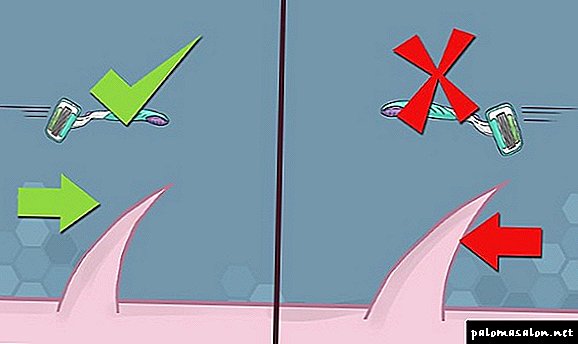
If the procedure is carried out with wax, then it is applied to dry skin, which is desirable to cool beforehand. The composition is torn off against hair growth.
When applying sugar paste, it is applied to the skin treated with talcum against the growth of hair, and torn off by growth.
Depilation
Ingrown hairs in the after-shave bikini area are less likely to appear if you use a sharp razor. This will greatly facilitate and speed up the procedure. For shaving optimal vegetation about 1 mm long. PBefore you get rid of long hair, they are recommended to be cut first.
- Take a hot bath before shaving.
- Then scrub the skin.
- A shaving product is applied to the treated bikini area.
- Remove vegetation with a razor.
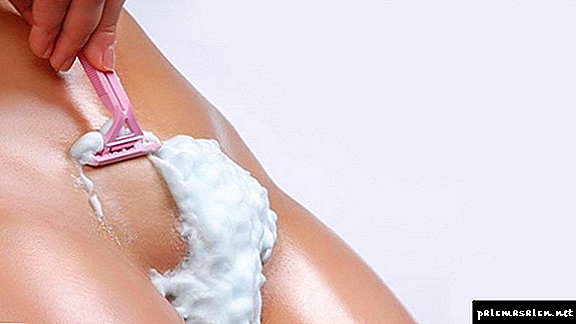
- Each time, conducting a tool on the surface of the skin, washed it under running water.
- Having finished shaving, wash off the remnants of cream and hair.
- The skin is dried, treated hands and bikini antiseptic.
- To make hair growth slower, lubricate the skin with a special agent.
- If skin is irritated, you should use an anti-inflammatory ointment.
- If there is a cut, you must immediately sanitize it, wash off the shaving cream, and stop the bleeding with a cotton swab.
The effect of depilation lasts only two or three days.
Waxing
Waxing is more painful, but the effect of it lasts for almost a month. Irritation and inflammation after the procedure is not uncommon, so it is important to follow the rules for skin care.
- The skin must first be treated with antiseptic, however, it must be dry.
- The wax is prepared: heated on a steam bath or in a special device and spread in a thin layer in the direction of hair growth.
- Then a strip is placed on top, the composition is allowed to clutch and with a sharp movement against the growth of vegetation it is torn off.
- Thus, the entire bikini area is treated.
- Then put means with anti-inflammatory action.
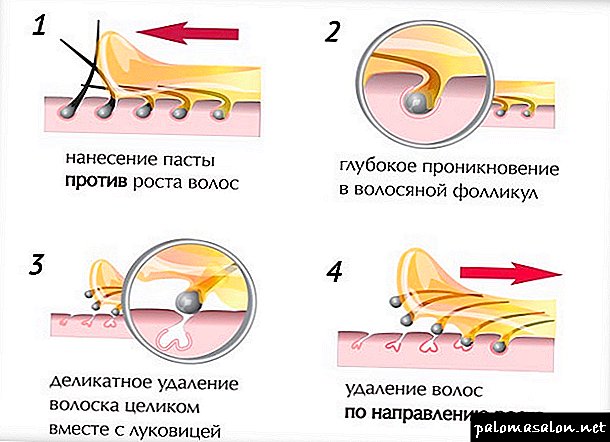
In the first days you need to lubricate the area of hair removal with antiseptic ointment. Peeling and scrubs do not use days 5-7.
What is the best way to remove hair
Ingrown hair in a bikini area will be less if you choose the right way to get rid of them. Experts recommend shugaring, as shaving involves frequent treatment of the specified area, and this is undesirable. The most preferred frequency of removal of vegetation: 1 time in 2 weeks.
Mechanical depilation through the epilator is also undesirable because the skin is injured. After exposure to the device, the direction of growth of hair rods changes, which only contributes to the formation of ingrown hair. Shugaring, in contrast to these methods, is a more delicate method of hair removal.
Rules of treatment and care after hair removal
- Immediately after the procedures should be wiped the skin with an antibacterial agent.
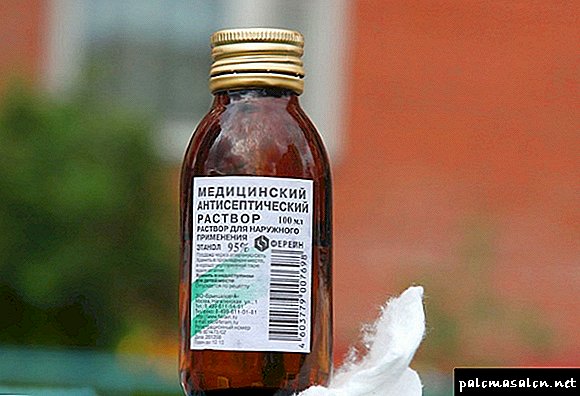
- Moisturizers and nutrients should be used, but only after the irritation has passed.
- On the 1st day after the procedure, water procedures are not recommended in the bathroom, in the shower, or in open reservoirs.
- Clothes need to choose from natural fabrics.
- Cutting clothing should eliminate friction in the treated area.
- 1-2 times a week, not more often, starting from 2 weeks. after hair removal, use scrubs and peels. After applying them, the skin should be moistened: lubricate with cream, milk or oil.
- Professionals recommend using a scrub when preparing for hair removal, and after the procedure, prefer peeling. It is important to remember that any composition can cause an allergic reaction, therefore, before applying to the treated area, the composition is checked by applying a small amount to the elbow bend.
- Scrub distribute massage movements for 2-3 minutes, then wash off with water.
Which doctor to contact
If the skin condition is disturbing (there are many purulent abscesses, or they increase in size, capturing new skin areas), you should contact a cosmetologist or a dermatologist, and later for surgical help.
Ingrown hair remaining under the skin cannot self-dissolve and causes even more inflammation. Sometimes an abscess is opened without help. Then the wound must be treated with antibiotics, and then closed with a sterile dressing.
Scrubs and Peelings Recipes
Ingrown hairs in the bikini area (how to get rid of them at home, discussed below) are recommended to be treated with home remedies. They should be used in advance, without waiting for the ingrown hair to fester.
If the ingrown hair already tears, then you can not use scrubs and peels.
Folk remedies
Ingrown hairs in the bikini area (how to get rid of them step by step mechanically, considered) can be removed and popular methods:
- Inflamed areas are dotted with toothpaste or water-diluted tooth powder. The composition is left for 30 minutes to dry, and then washed off.
- Olive oil will help soften the skin, so that the hair will penetrate to the surface of the skin. Heated olive oil should be lubricated with a bikini and left for 30 minutes, then rinsed with water.
- Badyagi powder is diluted with 3% hydrogen peroxide so as to make gruel. It is applied for 15 minutes every week.
- Salicylic acid can be treated point-ingrown hairs to reduce inflammation. It is necessary to use the composition of 5 days to hair got out on their own. Since salicylic acid is very dry skin, you need to rub the moisturizer after the procedure.
- According to popular practices, it is necessary to use a compress of baked onions. The onion is baked, then cut in half and applied to inflammation for 3 hours, after this time you need to cut a thin layer that came into contact with the skin, and make a compress again. According to reviews, such actions quickly lead to the opening of an abscess.
- Homemade onion ointment is prepared as follows: one onion is baked, turned into mush, add 1 tsp. liquid honey and flour. The resulting gruel smears inflammation up to 5 times a day.
- Another remedy that includes baked onions is a compress with the addition of rubbed soap. On 2 parts of onion take 1 part of soap, make applications directly on the site of inflammation.
- A more convenient tool is powder made from powder of rose petals of incense and aloe leaves. This powder helps to relieve inflammation. It should be used from 5 or more times a day.
- Can be used for treating skin apple cider vinegar.
Homeopathic remedies
Homeopathic remedies should be chosen with caution, as they can cause an allergic reaction. In addition, the tool is not intended for the intimate area, can disrupt the microflora.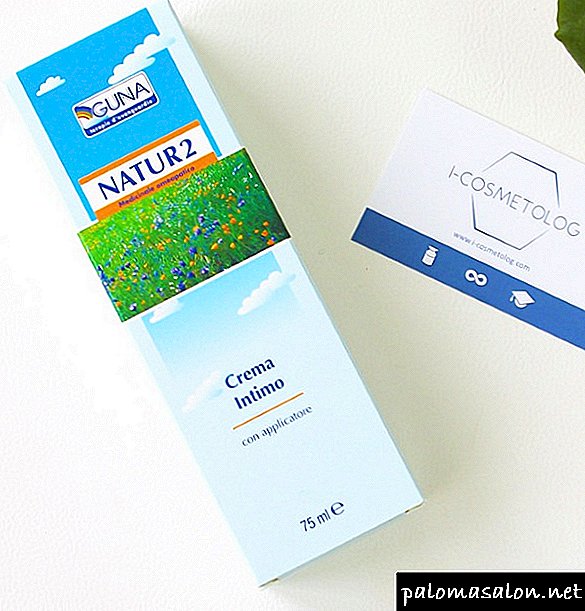
In any case, before using the tool, it must be tested: whether it will not cause allergies. The tool must have an anti-inflammatory effect, remove puffiness, accelerate tissue repair and have an antipruritic effect.
Among the effective homeopathic remedies should be called cream Natur 2 GUNA. It is designed directly for the treatment of the intimate zone, therefore it does not violate the microflora, improves the structure of the tissue, promotes skin moisture, and soothes inflammation.
Arnica cream has an antibacterial effect, removes inflammation, promotes skin regeneration with microtraumas, prevents the appearance of pigment spots.
Gel "Traumel C" is used for boils and inflammations. It blocks the development of infection, inflammation, has an antipruritic effect, relieves puffiness, has analgesic properties. It is necessary to process them bikini from 2 to 5 p. / D.
Medication
Ingrown hair in a bikini area (how to get rid of them with the help of cosmetics and which ones to choose from is described below) will not be inflamed if the following drugs are used for hair removal:
- Miramistin, which is an effective antiseptic. They should treat the skin after hair removal. It prevents the reproduction of bacteria inside.
- Chlorhexidine (also antiseptic) - has anti-inflammatory properties.
- Furacilin - kills bacteria that can cause inflammation.
- Retin-a is a drug that prevents clogged pores and keratolization of the skin.
Cosmetics for ingrown hair
Kalo Hair Inhibitor – 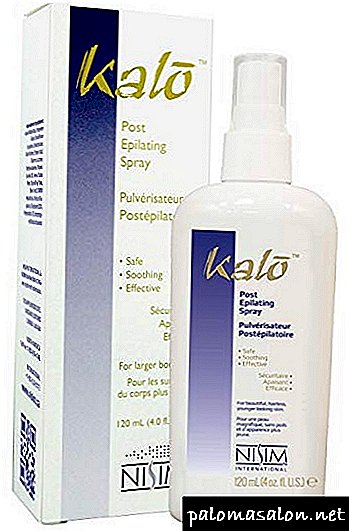 spray based on plant extracts. It slows down hair growth, does not cause irritation and itching.
spray based on plant extracts. It slows down hair growth, does not cause irritation and itching.
If you use the lotion regularly, it will moisturize the skin well, prevents the appearance of inflammation and ingrowth.
It not only slows down hair growth, but also makes them thin. It is used three times every 15 minutes immediately after removal of the vegetation.
On the second day, the treatment is repeated. If a razor is used, the skin should be cleaned every time after the procedure.
Tend Skin (lotion) - soothes inflammation, suitable for sensitive skin, at the same time disinfects, reduces pigmentation.
It is used both after manipulation and during processing before the procedure. Lotion prevents the appearance of irritation.
It is distributed and not washed off.It has antiseptic properties, as it contains aspirin and isopropanol. Mitigating effects have components such as glycerin, propylene glycol, cyclomethicone.
Similar to the previous drug is Skin Doctors Ingrow Go lotion. According to the manufacturer, inflammation and pigmentation will be eliminated as soon as possible, literally in one day.
In fact, it does not help so quickly, but is really effective. As in the previous preparation, the active ingredients are isopropanol, propylene glycol and aspirin. The tool is applied with a cotton pad immediately after shaving or a day after epilation.
If you do not want to mess with powder badyagi, you can use the gel "Badyaga Forte." It has an antibacterial, anti-inflammatory effect, accelerates skin regeneration. The drug is applied to the treated area for 30 minutes, then washed off with water.
Ointments to relieve inflammation
Ingrown hairs in the bikini area (how to get rid of them, has already been described) in the presence of inflammation are treated with antibiotic ointment. It blocks the reproduction of bacteria. It is prescribed when the hair began to tear. Before applying the ointment area must be disinfected.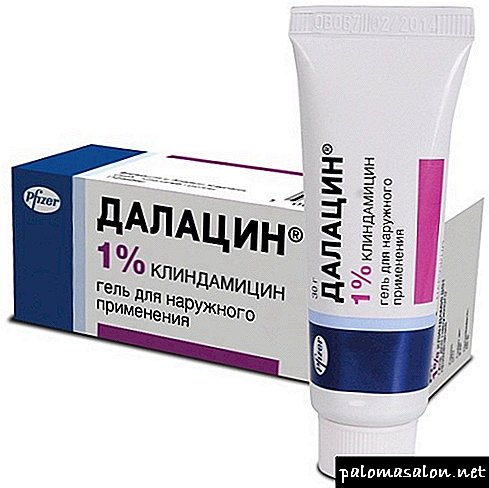
The product is used 1-2 rd, and in conjunction with scrubs, peeling it is not recommended to use it, because it dries the skin. In order to prevent the interaction of the ointment with other means, it is recommended to apply it an hour after applying any other means.
Dalatsin 1% gel contains clindamycin phosphate at the base. They need to process the skin 2 p. / D.
From suppuration apply lotion "Tretinoin". Its main purpose is the treatment of acne, however, it contributes to the opening of boils and their rapid healing. It is applied after water procedures 1 p. / D. After a few hours you need to wash it off.
Ichthyol ointment is applied overnight in case of boils directly on the site of inflammation. Then the plot is wrapped with cling film and left until morning. Processing spend 2 p. / D. daily.
Antibiotics
If an abscess has begun, antibiotics should be taken orally. One effective is Cephalexin. It is taken within 1-2 weeks as prescribed by a doctor. Self-treatment can cause side effects associated with impaired digestion, low blood pressure, allergies, reactions of the cardiovascular system.
Tetracycline is also taken orally every 6 hours, 1 tablet as directed by a physician.
Complications and consequences
If we do not take appropriate measures in time, the irritation that appeared at the initial stage will not be limited to the process. Damage is transformed into an abscess, accompanied by hyperpigmentation. With a long process, infection of nearby tissues is possible.
In severe cases, if the inflammation does not go away and lumps appear that are filled with white fluid, which is pus, you have to resort to surgical care, since self-removing an abscess can cause blood poisoning and aggravate the situation.
If a lump is formed, there is a possibility that this is a sign of not only ingrown hair, but also the development of a dermatological disease, neoplasm. Similar symptoms sometimes occur with lichen, folliculitis, phrytoderm. Any injury can lead to serious consequences.
It is necessary to contact a dermatologist or a cosmetologist. Based on the results of the examination, he will conclude that this is the cause of the inflammation. The doctor may send for additional tests to clarify the type of pathogen or biopsy.
To make a correct diagnosis, it is necessary to determine the relationship between epilation and inflammation. If it appeared immediately after hair removal, it is exactly ingrown hair.
Ingrown hairs in the bikini area (how to get rid of them yourself, discussed in detail in the article) should be removed: the sooner this is done, the better, since the abscesses in the bikini area are easy to injure with clothes. And this is a direct path to the development of an abscess.
In addition, with the development of inflammation, boils cause pain when moving. It is necessary to treat the area with antibiotic ointment and, when the inflammation has passed, steam out the skin and make a peeling.
If the bump does not cause significant discomfort, you should temporarily abandon epilation and treat the site of localization with antibacterial ointments, such as Baziron, Proderma, Dalacin. If the improvement does not occur, then you need to contact a beautician.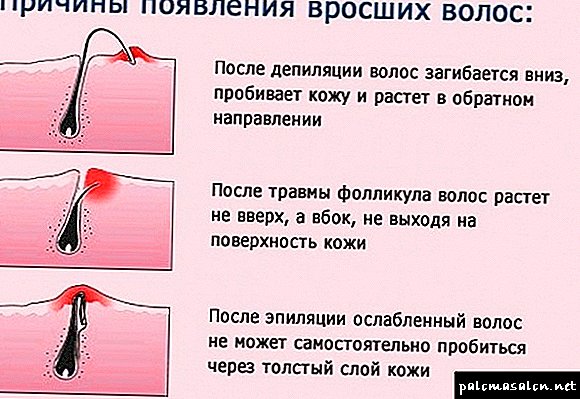
After hair removal, a dark spot may form in its place, then you need to act in the following order:
- Systematically peeling. This will help remove the top layer of skin and brighten the area.
- Apply daily regenerating ointment, for example, Badyagu Forte or salicylic, distributing it for 15 minutes and then removing it with water.
- Wipe the skin with homemade lotion, for example, with lemon juice or castor oil or apply a mask with aspirin. This will help lighten the spots.
To get rid of ingrown hairs in the bikini area at home, you must comply with all the requirements for disinfection and the course of the procedure. In severe cases, it is recommended to seek surgical treatment, as inept actions can cause the development of a secondary infection.
Article design: Mila Friedan
Best tools
What to do with ingrown hair? Many prefer to use various drugs and medicines:
- "Retin-A." Reduces clogging of the skin, prevents skin thinness.
- Antibiotics for topical use. Apply if there was suppuration, there were boils. The doctor may prescribe "Clindamycin", "Chlorhexidine", "Erythromycin".
- Neet and Nair. Chemical depilatories contribute to the weakening of the hair structure. It is not recommended to use constantly.
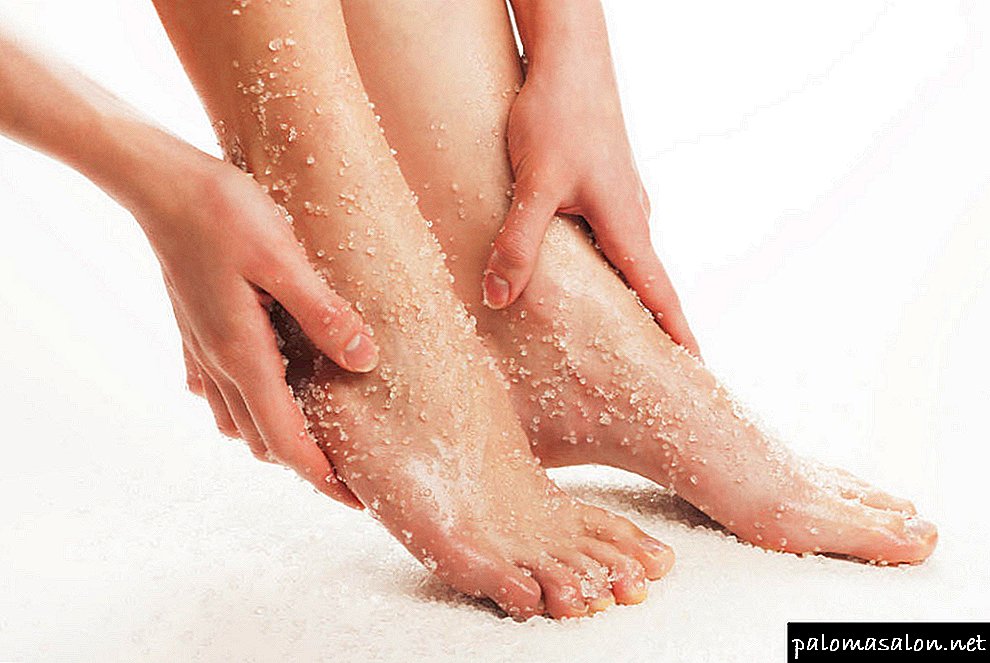 Scrubbing of the skin against ingrown hair
Scrubbing of the skin against ingrown hair
ethnoscience
If hair grows, how to treat with traditional medicine:
- Onion wrap. In milk, you need to boil the onion, then knead. Onion gruel to attach to the inflamed area.
- Baked onions. Half the onions bake and attach to the right place cut down. Secure with a medical bandage. After 4 hours you need to cut a small layer of the bulb in the place of its contact with the skin, bandaged. Continue the procedure until the inflammation passes.
 Aloe Leaf is often used in recipes
Aloe Leaf is often used in recipes
Getting rid of stains
After ingrown hairs spots may appear. If you do not remove them at the very beginning, they can turn into scars. How to remove traces from ingrown hair:
- "Badyaga." Add lemon juice to lemon juice. Apply point to spots. Duration - 15-20 minutes. The course of treatment consists of 3-5 procedures.
- Essential oil. Stains lubricate 3-4 times with essential oil. The most effective are ylang-ylang and lavender oil.
- Cream "Ahromin". Apply a small amount to the stain several times during the day. After 7 days the spots will disappear.
experience
Beauty salon managerAug 2016 - Sep 2018 (2 years 2 months)
Salon-boutique valery Beauty / Fitness / Sport
Senior administratorDec 2014 - Aug 2016 (2 years 1 month)
Beauty Salon-de-provence Beauty / Fitness / Sport





